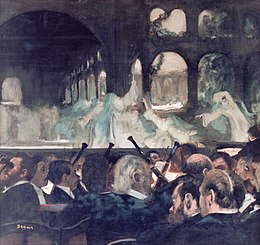
Back الأوبرا الكبرى Arabic Grand opéra Catalan Grand opera Czech Grand opéra Danish Grand opéra German Granda opero Esperanto Grand opéra Spanish Grand opéra Finnish Grand opéra French Grand opéra Galician

Grand opera is a genre of 19th-century opera generally in four or five acts, characterized by large-scale casts and orchestras. The original productions consisted of spectacular design and stage effects with plots normally based on or around dramatic historic events. The term is particularly applied (sometimes specifically used in its French-language equivalent grand opéra, pronounced [ɡʁɑ̃t‿ɔpeʁa]) to certain productions of the Paris Opéra from the late 1820s to around 1860;[1] 'grand opéra' has sometimes been used to denote the Paris Opéra itself.
The term 'grand opera' is also used in a broader application in respect of contemporary or later works of similar monumental proportions from France, Germany, Italy, and other countries.[2]
It may also be used colloquially in an imprecise sense to refer to 'serious opera without spoken dialogue'.[3]
- ^ 'French opera of the Romantic period, sung throughout, generally in five acts, grandiose in conception and impressively staged.' (Grove Music Online definition of 'grand opéra': consulted 27 August 2011)
- ^ 'Nineteenth-century opera of a certain large-scale type.' Charlton (2003), p.xiii
- ^ 'Grand opera', Oxford Companion to Music
© MMXXIII Rich X Search. We shall prevail. All rights reserved. Rich X Search